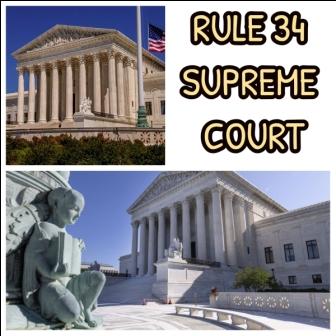What is Rule 34 Supreme Court United States?
Origin and development of Rule 34 Supreme Court:
Rule 34 of the Supreme Court is a rule that governs oral arguments before the highest court of the United States. It specifies the conditions and procedures for presenting the cases to the justices in a clear and concise manner. Oral arguments are an important part of the appellate process, as they allow both parties to directly communicate their points and answer the questions of the judges
Rule 34 Supreme Court refers to the procedural rules governing oral arguments before the United States Supreme Court. It establishes guidelines for when, how, and under what conditions oral arguments may be presented to the Court in a given case.
Rule 34 has its origins in the Judiciary Act of 1789, which created the Supreme Court and granted it the power to review cases from lower courts. The Act also authorized the Court to establish its own rules of practice and procedure. The first set of rules was adopted by the Court in 1790, and they have been revised and amended over time to reflect the changing needs and circumstances of the judicial system.
One of the most significant changes to Rule 34 occurred in 1925 when Congress passed the Judiciary Act of 1925, also known as the Judges’ Bill. This legislation gave the Court more control over its caseload by allowing it to choose which cases to hear on appeal from lower courts. The Act also required parties who wished to have oral arguments before the Court to file a petition for a writ of certiorari, which is a request for the Court to review a lower court’s decision. The Court would then decide whether to grant or deny certiorari based on the importance and novelty of the legal issues involved.
Another major change to Rule 34 happened in 1970, when the Court adopted a new rule that limited oral arguments to 30 minutes per side unless otherwise ordered by the Court. This rule was intended to reduce the length and number of oral arguments, which had increased significantly over the years. The rule also encouraged parties to focus on the most essential and relevant points of their cases and to prepare concise and clear presentations for the justices.
Rule 34 has been instrumental in shaping the oral tradition of the Supreme Court, which is an important part of its decision-making process. Oral arguments provide an opportunity for the justices to ask questions, clarify doubts, test opinions, and challenge assumptions. They also allow parties to persuade the Court with their logic, evidence, and rhetoric. Oral arguments can sometimes make a difference in the outcome of a case, especially when it is closely contested or involves complex or novel questions of law among parties.
Concept and object of Rule 34 Supreme Court :
According to Rule 34, the parties who wish to have oral arguments must submit their written briefs first, followed by the response of the other side. The Court will then decide whether to grant or deny the request for oral arguments. If granted, the Court will schedule the date and time for the hearing, and notify the parties accordingly.
The oral arguments are usually held from October to April, on Mondays, Tuesdays, and Wednesdays, starting at 10 a.m. Each side is allotted 30 minutes to present their case unless otherwise ordered by the Court. The justices may interrupt the speakers at any time with questions or comments. The arguments are open to the public, but seating is limited and on a first-come, first-served basis.
The oral arguments are also recorded and transcribed by the Court Reporter and made available on the Court’s website. The audio recordings are usually released on Fridays after the arguments. The transcripts and recordings can help the public and the media to understand the issues and arguments involved in each case.
Oral arguments are essential in the United States judicial system:
Rule 34 of the Supreme Court is a rule that deals with oral arguments during appellate court proceedings. It outlines the conditions and procedures needed for such presentations to take place. Oral arguments are essential in the United States judicial system, allowing both parties to present their cases directly before the justices clearly and concisely.
Important and relevant case law of rule 34:
Some examples of cases that have been argued before the Supreme Court under Rule 34 are:
Brown v. Board of Education (1954), a landmark case on racial segregation in public schools
Miranda v. Arizona (1966): This case involved the rights of criminal suspects during police interrogations. The Court heard oral arguments from both sides and also listened to recordings of actual interrogations. The Court ruled that suspects must be informed of their rights to remain silent and to have an attorney before being questioned and that any statements made without such warnings could not be used as evidence against them³.
Roe v. Wade (1973):
This case challenged the legality of state laws that restricted or prohibited abortion. The Court heard oral arguments from both sides and also considered medical, historical, and sociological evidence on the issue. The Court ruled that women had a fundamental right to privacy that included the decision to terminate a pregnancy, subject to some limitations by the state.


